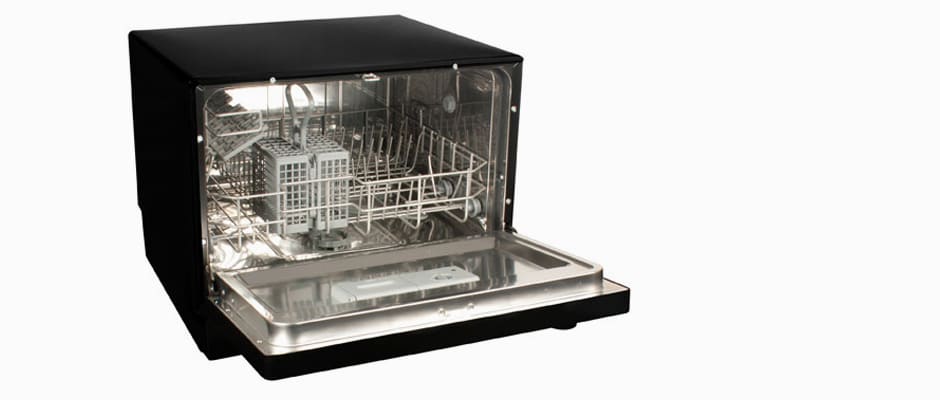Pros
Cons
Introduction
While we've seen many positive user reviews for countertop dishwashers, this is the first time the {{product.name}} has been given a rigorous, scientific test. Despite its small size and low price tag (around $175 online), this compact washer did a great job getting dishes clean while using very little energy and water.
Front
{{section_header}}{{section.name}}{{/section_header}}
The {{product.name}}'s door looks quite cheap, with glossy black plastic and an obvious gap between the door and bottom panel. It'll definitely attract fingerprints.
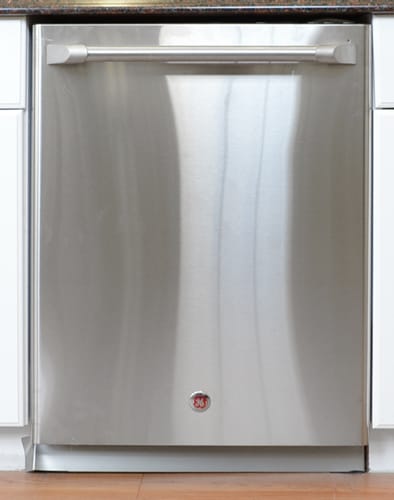
The front of the GE CDWT980VSS.
Controls
{{section_header}}{{section.name}}{{/section_header}}
Controls consist of plastic membrane keys for on/off and start/stop. There's also a dial for selecting wash cycles.
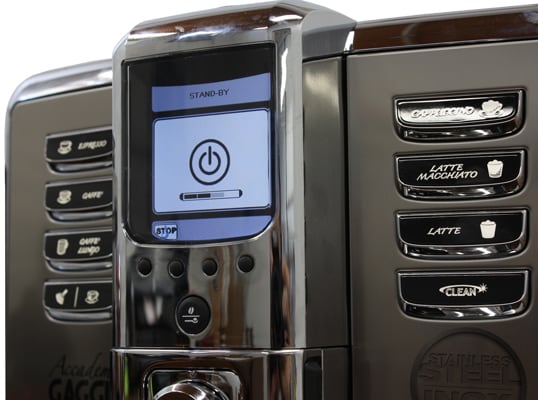
Interior
{{section_header}}{{section.name}}{{/section_header}}
Inside, there's a stainless tub. That's a feature that most entry-level full size dishwashers don't even have.
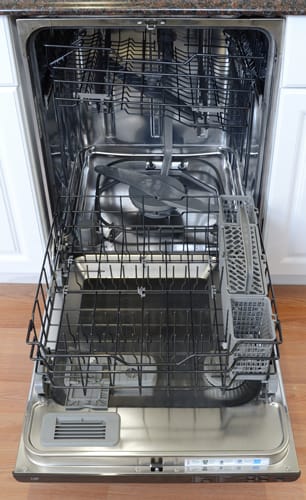
The CDWT980VSS with door open.
Top Rack
{{section_header}}{{section.name}}{{/section_header}}
There's only one rack on this dishwasher.
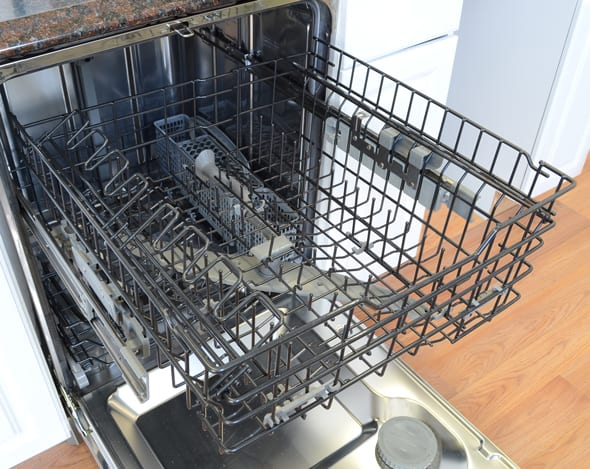
The top rack of the CDWT980VSS.
Cutlery Basket
{{section_header}}{{section.name}}{{/section_header}}
The cutlery basket is removable.
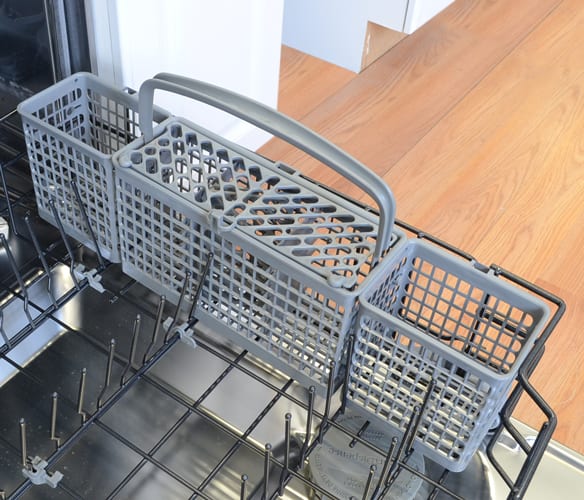
The CDWT980VSS cutlery basket.
Electricity Use
{{section_header}}{{section.name}}{{/section_header}}
The {{product.name}} draws warm water, and its wash cycles don't get above 147 degrees. That means it doesn't need to use a lot of energy to heat water internally. Most wash cycles used between 0.26 and 0.48 kWh of electricity.
{{ attachments(51099cd90dac5cc9eb0004a0)
Water Use
{{section_header}}{{section.name}}{{/section_header}}
The Koldfront used between 2.5 and 4.2 gallons of water per wash, depending on the cycle. A small dishwasher just doesn't need that much water, and chances are it uses a lot less H2O than you do when you clean dishes by hand.
Yearly Running Cost
{{section_header}}{{section.name}}{{/section_header}}
In an average year of washing dishes, the operating cost of the {{product.name}} would be a mere $18.23. Compare that with the time spent cleaning dishes by hand, and it may seem like a pretty good value.
{{ attachments(50fc5209bd0286de7b000828)
Washing Speed
{{section_header}}{{section.name}}{{/section_header}}
Some dishwashers take hours to complete a load. This is not one of those dishwashers. The {{product.name}}'s cycles range from under an hour for a quick wash to just over an hour and a half for a heavy duty cycle.
{{ attachments(510bd435cba1336a5a0009ff)
Washing Performance
{{section_header}}{{section.name}}{{/section_header}}
You may not be able to fit a lot of dishes in the {{product.name}}, but those that make it inside will end up clean. For our tests, we load dishes with a standard amount of filth to test how well a dishwasher does at its limits. That's why most dishes emerge with some dirt left on them. If you scrape or prewash your dishes, they'll most likely come out much cleaner.
A word of caution: this dishwasher had some trouble cleaning items in the back corners. We'd also recommend loading items so that their most soiled parts are facing towards the spray arm.
Quick Wash Cycle
{{section_header}}{{section.name}}{{/section_header}}
In 45 minutes, the {{product.name}} got most dishes pretty clean. We'd recommend using this cycle for most light washes, as it performed nearly as well as the much longer normal cycle.
Normal Wash Cycle
{{section_header}}{{section.name}}{{/section_header}}
The normal cycle took 40 minutes longer than the quick cycle, but only produced marginally better results. Save time and use the quick cycle instead.
Heavy/Pots & Pans Wash Cycle
{{section_header}}{{section.name}}{{/section_header}}
Even hardened lasagna and a burnt creme brulee were no match for the {{product.name}}, which tackled sullied pots and pans with aplomb. It did have a little trouble with cheese, however, which we attribute to a relatively low wash temperature of 147 degrees.
Washing Cycles
{{section_header}}{{section.name}}{{/section_header}}
In addition to five full cycles, there's also a ten minute rinse option. That'll come in handy after a full cycle if you're planning on storing this portable dishwasher, as it rinses out most of the crud that a full wash leaves behind.
Customization
{{section_header}}{{section.name}}{{/section_header}}
Washes can't be customized, but there are enough options on offer that you shouldn't have a problem choosing one that's right for your particular dishes.
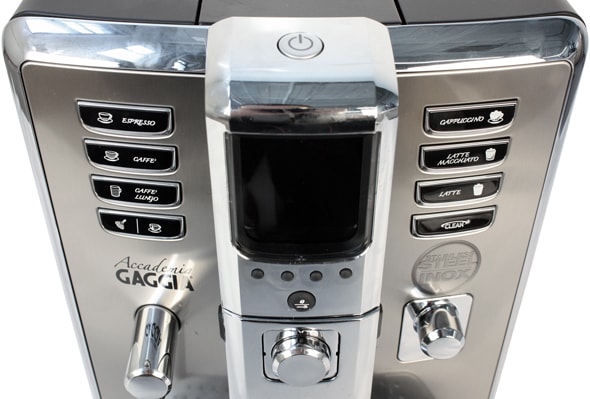
Additional Wash Options
{{section_header}}{{section.name}}{{/section_header}}
There really aren't any options on this washer. It's portable, so at least you can lug it into a cabinet somewhere -- but it's still pretty heavy.

Capacity
{{section_header}}{{section.name}}{{/section_header}}
While this Koldfront's owner's manual claims a six place setting capacity, we could only fit four settings inside. It's a short dishwasher, so taller plates and serving dishes will have to lay flat. That takes up even more space.
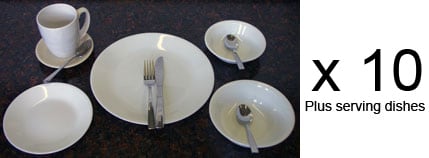
Top Rack
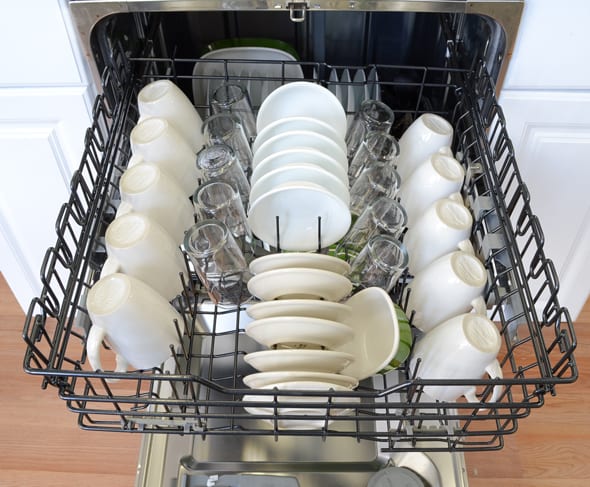
Bottom Rack
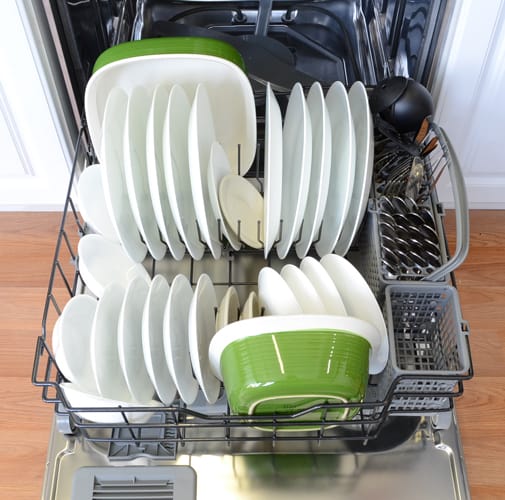
Wash Arms & Filters
{{section_header}}{{section.name}}{{/section_header}}
There's a single wash arm at the bottom of the unit. There's also a strainer and filter that's thankfully removable, since it got clogged after every wash cycle we tested. If you don't wash this out, your dishes won't get clean and the interior of the washer will start to smell like rotting wet food.
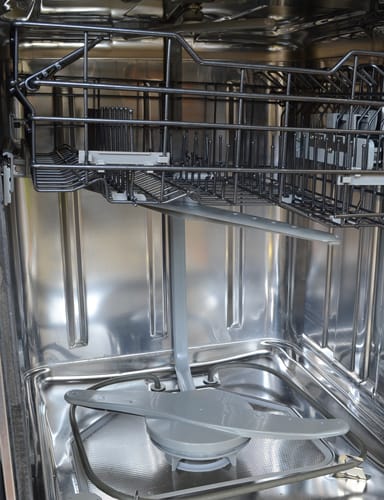
The CDWT980VSS wash arms.
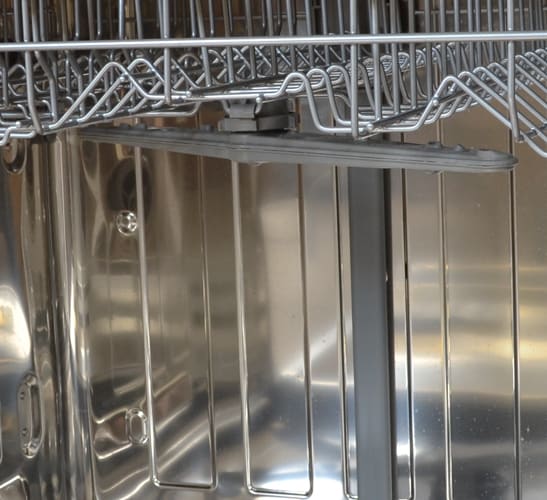
The DW 14140 upper wash arm
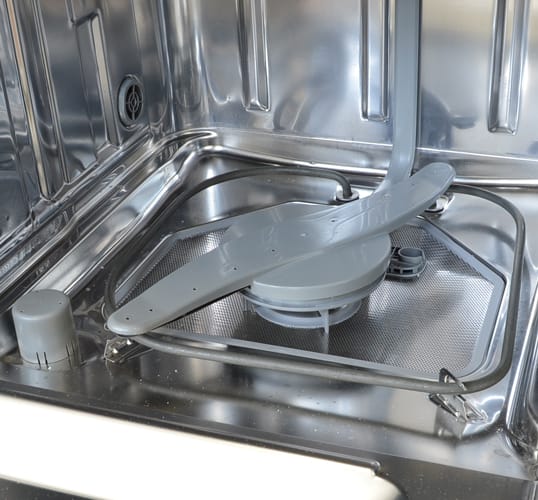
The CDWT980VSS filter.
Upper Dish Rack
{{section_header}}{{section.name}}{{/section_header}}
There's only one dish rack. Made of rubberized metal, it's hardly adjustable. You can remove the cutlery tray and fold down a very shallow shelf, but otherwise all the tines are fixed. We found them a little close together to fit some larger bowls, which impinged on total usable space.

The top rack of the CDWT980VSS.
Cutlery Holder
{{section_header}}{{section.name}}{{/section_header}}
The cutlery holder is removable and features oddly shaped holes -- some of which don't fit the handles of many silverware patterns.

The CDWT980VSS cutlery basket.
Detergent Dispenser
{{section_header}}{{section.name}}{{/section_header}}
The detergent dispenser has compartments for small and large washloads. Next to it is a rinse aid dispenser.
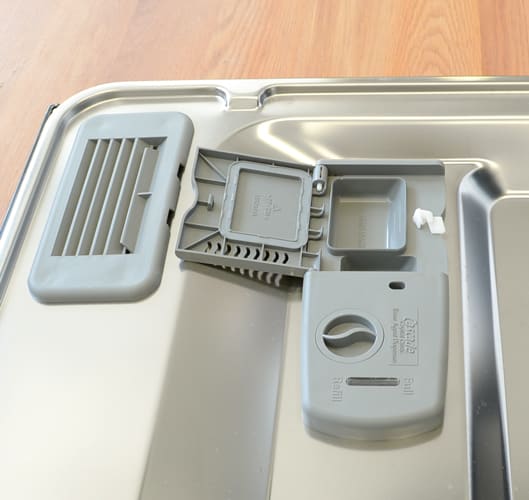
The CDWT980VSS detergent dispenser.
Ease of Use
{{section_header}}{{section.name}}{{/section_header}}
The {{product.name}} must be hooked up to a sink. Usually, that requires removing the sink aerator and screwing on a "quick connect" attachment. We had to purchase a 15/16" to 55/64" adapter in order to hook ours up onto the sink in our test laboratory. If you have a faucet with an integrated aerator, this washer might not work for you -- or you may need to do a little plumbing.
Otherwise, its controls are straightforward, and as long as you don't pack it full of dishes, the {{product.name}} is pretty easy to load.
Noise
{{section_header}}{{section.name}}{{/section_header}}
This is not a quiet dishwasher. The hum of the drain pump, the whirr of the motor and the rush of water will punctuate your kitchen while it's in use.
Controls
{{section_header}}{{section.name}}{{/section_header}}
There are just three controls on this unit: a plastic membrane on/off button, a similar start/pause button and a big plastic knob for selecting a cycle. To find out what the cycles mean, you'll have to consult the thorough owner's manual.


Efficiency
{{section_header}}{{section.name}}{{/section_header}}
We estimated that an average year with the {{product.name}} would set you back just over $18 in water and electricity costs. That's very efficient compared to most dishwashers, and much less than you'd spend on water if you hand wash.
Washing Performance
{{section_header}}{{section.name}}{{/section_header}}
Dishes emerged just as clean as they would from a full sized model -- if not cleaner. Just make sure to load items properly, and clean the filter after each wash.
Features
{{section_header}}{{section.name}}{{/section_header}}
There aren't any special features on this dishwasher, with the exception of its small size and portability. It's heavy, but you could even store it in a closet when it's not in use.
Meet the tester
Keith was the Editor in Chief of Reviewed's appliance and automotive sites. His work has appeared in publications such as Wired, Car & Driver, and CityLab.
Checking our work.
Our team is here to help you buy the best stuff and love what you own. Our writers, editors, and experts obsess over the products we cover to make sure you're confident and satisfied. Have a different opinion about something we recommend? Email us and we'll compare notes.
Shoot us an email